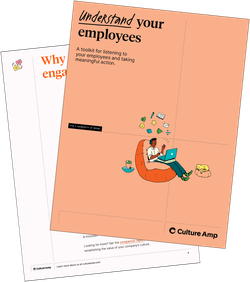
Understanding what an engaged employee looks like

Written by

Director of People Science Research, Culture Amp
We can generally recognize if people are happy or sad, calm or upset. These common emotions are clear, and we’re exposed to them from an early age. However, understanding if someone is engaged with their work is a more complex task. Do you know what an engaged employee looks like?
At Culture Amp, we define employee engagement as the levels of enthusiasm and connection employees have with their organization. An employee engagement survey is the best way to understand if your employees are engaged or not, and what’s driving engagement. The Culture Amp employee engagement survey uses five questions to determine employee engagement. The questions encompass employees’ level of pride, recommendation, motivation, present commitment, and future commitment.
In addition to surveying employees to understand the components of engagement, certain behaviors also show engagement. Wilmar Schaufeli, a professor of work and organizational psychology at Utrecht University in the Netherlands (and many others), has studied the visible behaviors of employee engagement.
When we can understand and spot behaviors that exhibit engagement at work, we deepen our knowledge of the experience of employee engagement.

Boost engagement at your company
How to recognize behaviors of an engaged employee
Employee engagement is the opposite of burnout
In general, employee engagement behavior can be considered the opposite of burnout. Schaufeli, along with three other researchers, tested and found support for the hypothesis that burnout and engagement are opposites. People who are engaged feel energized by their work, whereas people experiencing burnout come home feeling exhausted. This is important because, despite engagement driving employees to work longer hours, they don’t experience the negative consequences of overtime and actually maintain positive mental health. Basically, they delight in their work rather than acting like they can’t wait to get it over with.
Engaged employees do more good deeds
Engaged employees help fellow employees and go outside their formal job descriptions without being asked to do so. In academia, this behavior is referred to as organizational citizenship behaviors (OCB) or discretionary effort. Researcher Bruce Louis Rich found that when an environment supports engagement, engaged individuals perform OCBs.
To explain this result, Rich said, “[engaged employees] simply throw their full selves into their roles, which they understand to include any activity that could potentially contribute to their effectiveness.” An additional meta-analysis covering publications from 1990 to 2010 also found evidence that engagement predicts extra-role performance beyond job satisfaction, job involvement, and organizational commitment.
Engaged employees work in a state of flow
There is evidence that engaged employees work longer hours. This doesn’t mean engaged employees are always working overtime, nor would we advocate for that. But the question is, why? One potential reason is engaged employees enter a state of flow that keeps them focused. If you’ve ever felt surprised at the amount of time that passed while you were working (and enjoyed what you were doing), you were in a state of flow. Just as engaged employees throw their full selves into their work roles, they also throw their whole selves into the experience of completing a task.
Edward Phillips, M.D., an Assistant Professor at Harvard Medical School, explains, “Flow experiences occur when there is a balance between the challenge of an activity and the skill you have in performing it.” When the challenge of an activity is low, and your skills are high, you’re likely just bored. Flip the scales, and you might be frustrated or overwhelmed by a task.
For employees to experience a state of flow at work, companies must create an environment that supports this behavior. To encourage a flow state in your workplace, reduce unnecessary distractions, and help employees find their sweet spot between challenge and skill.
Why does recognizing employee engagement matter?
On an individual level, familiarity with employee engagement behaviors provides a further understanding of employee engagement at work. These behaviors bring to life employee engagement survey results because they’re what we see day-to-day. Staving off burnout, going above and beyond, and working in a state of flow also drive many positive business outcomes associated with engagement, like customer satisfaction, productivity, and profit.



